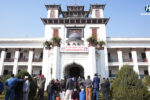For four decades, China’s economy seemed unstoppable. Fueled by massive foreign investment, an endless supply of cheap labor, and insatiable global demand for its exports, China’s GDP growth regularly exceeded 10% per year.
Hundreds of millions were lifted out of poverty as a new middle class emerged.
The leaders of the Chinese Communist Party (CCP) boldly claimed credit, asserting that China’s economic “miracle” proved the superiority of their authoritarian system.
But the miracle has turned to mirage, the foundations of China’s growth model eroded by the CCP’s own policies and hubris.
The cracks emerged even before COVID-19, but the Party’s draconian lockdowns sent the economy into freefall.
China’s property sector, which accounts for up to 30% of GDP, is in crisis as overleveraged developers default.
Unemployment is soaring, especially among the young. And foreign investors are fleeing in droves, no longer willing to tolerate the CCP’s unfair practices and rising geopolitical risks.
The CCP thought it could bully and manipulate its way to permanent prosperity, but it overplayed its hand.
The government has focused on creating a more conducive environment for businesses to thrive, streamlining processes and reducing bureaucratic hurdles.
For years, China strong-armed foreign companies into handing over advanced technologies and intellectual property as the price of market access.
It subsidized strategic industries, from solar panels to electric vehicles, wiping out overseas competition.
But instead of becoming more innovative on its own, China remained dependent on the West for the highest-value components and know-how.
Meanwhile, the Party prioritized political control above all else. Private businesses faced arbitrary crackdowns and shakedowns.
The tech sector was hobbled by draconian regulations in the name of “common prosperity.” At the same time, the CCP enabled massive malinvestment and speculation, especially in real estate.
Local officials ran up huge debts building ghost cities and vanity projects. The lack of secure property rights fueled a housing bubble of epic proportions.
This house of cards could not stand forever. When the pandemic hit, the CCP resorted to brutal lockdowns, shattering consumer confidence and disrupting supply chains.
Millions of small businesses folded, while multinationals accelerated plans to diversify away from China. Even more damaging was Xi Jinping’s crackdown on the private sector, exemplified by the torpedoing of Ant Financial’s IPO in 2020. Entrepreneurs got the message: toe the Party line or face ruin. Predictably, business investment has plummeted.
Foreign investors are equally disillusioned. The latest data shows FDI into China at a 20-year low. Global firms face rising pressure from both Beijing and their home governments over human rights, Taiwan, and technology controls.
Business confidence has plunged as Xi consolidates power and ratchets up anti-Western rhetoric. Even the Europeans, long deferential to Beijing, are fed up with the lack of reciprocity.
China remains a critical market, but one fraught with risks many are no longer willing to bear.
India, with its vast domestic market and more open political system, is the biggest beneficiary of this rebalancing. Major manufacturers from Apple to Samsung are ramping up production there.
Unfortunately, all signs point to Xi and company taking the country backward. Having bet everything on an all-powerful Party-state, they are now boxed in, with no clear path to reversing course.
While India faces daunting challenges, it has several key advantages over China. These include a growing working-age population, a vibrant private sector, stronger property rights, and warmer ties with the West.
If Prime Minister Modi can turbocharge reform and investment, India could become the new workshop of the world.
In recent years, India has taken significant strides to enhance its economic landscape and attract foreign investment by implementing a series of structural reforms.
The government has focused on creating a more conducive environment for businesses to thrive, streamlining processes and reducing bureaucratic hurdles.
Additionally, India has embraced the digital revolution, recognizing the immense potential it holds for the country’s growth.
None of this means China’s economy will collapse overnight. It is still the second-largest in the world with tremendous assets.
But the CCP’s state capitalist model is running out of steam. Unfavorable demographics, declining productivity, and rising debt levels all point to dramatically slower growth ahead – and greater instability.
Desperate to shore up legitimacy as economic pain mounts, the Party will likely double down on nationalism and repression.
Ultimately, China’s woes are largely self-inflicted. By putting politics above economics, the CCP has squandered much of the progress of the past 40 years. It now faces a choice between clinging to control and returning to market-driven reform.
If the former, China will continue to stagnate and turn inward, while the world moves on. Only by loosening its grip can the Party revitalize China’s economy for the long term.
Unfortunately, all signs point to Xi and company taking the country backward. Having bet everything on an all-powerful Party-state, they are now boxed in, with no clear path to reversing course.









Comment